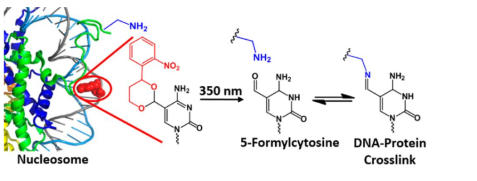The 5-formylcytosine (5fC) has been identified as a naturally occurring nucleobase in genomic DNA. It was initially thought to be merely an intermediate in the ten-eleven translocation (TET) enzyme-mediated DNA demethylation pathway. More recently, 5fC was found to be a stable DNA modification that exists for weeks in mammals. This modification can alter the structure of the DNA double helix and is possibly involved in transcription regulation and chromatin remodeling. However, how 5fC plays it roles in these processes remains to be illustrated.

Recently, Xi and Zhou’s group discovered a new function of 5fC. Through in situ generation of 5-formylcytosine (5fC) in nucleosome core particles (NCPs), they revealed that 5fC leads to essential DNA−protein cross-links (DPCs). Mechanistic studies using chemical models and mutated histones demonstrate that DPCs form reversibly between the formyl function of 5fC and primary amines on histones. These results suggest that DPC formation from 5fC in chromatin occurs in addition to its role in DNA demethylation. After publication in JACS, this work was featured inJACS Spotlight.
Link: http://pubs.acs.org/doi/10.1021/jacs.7b05495